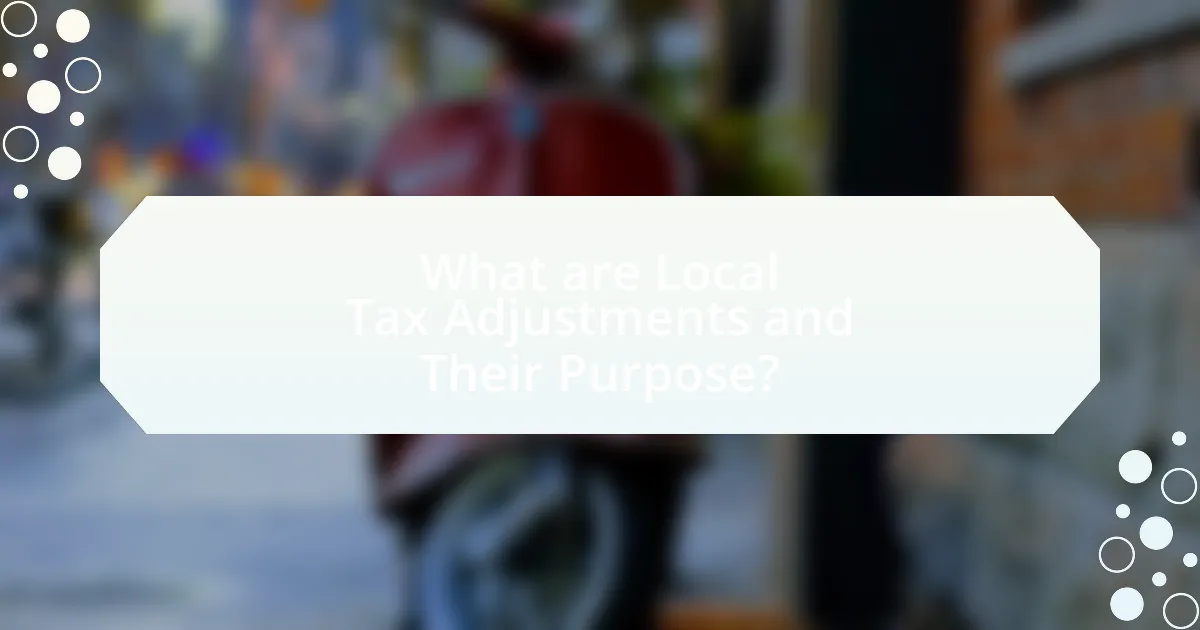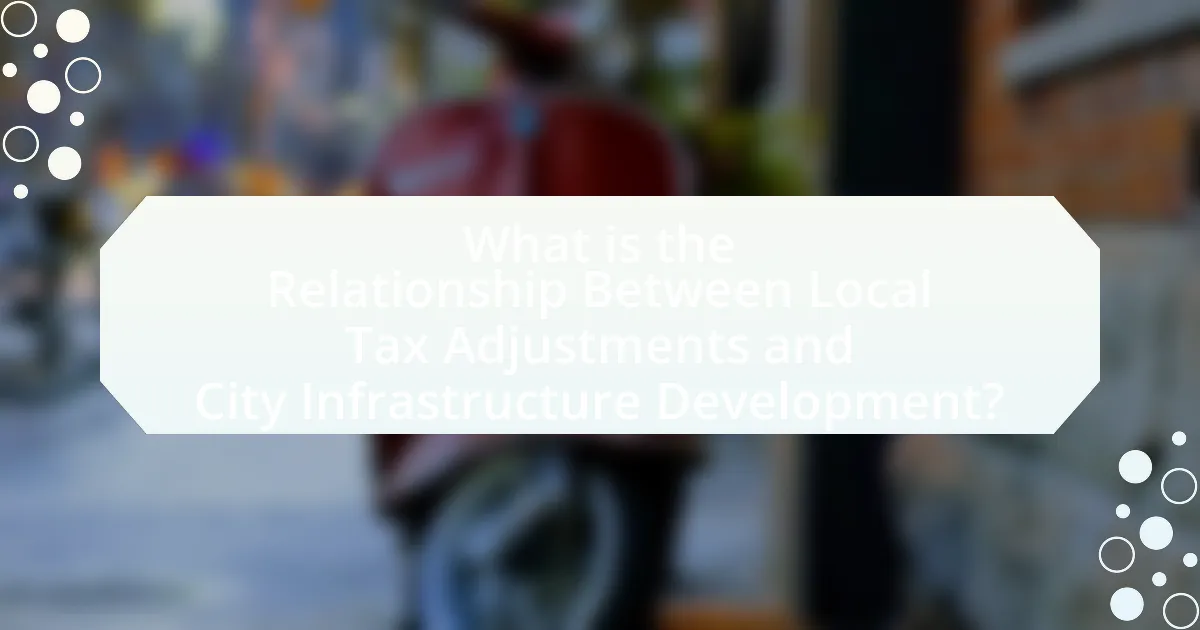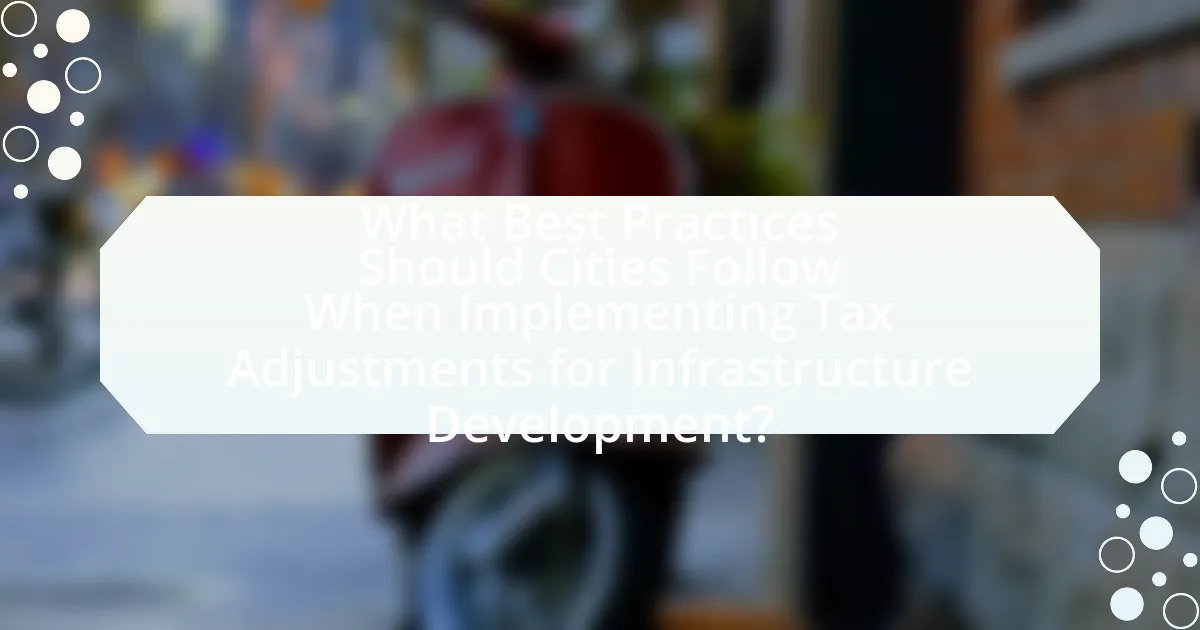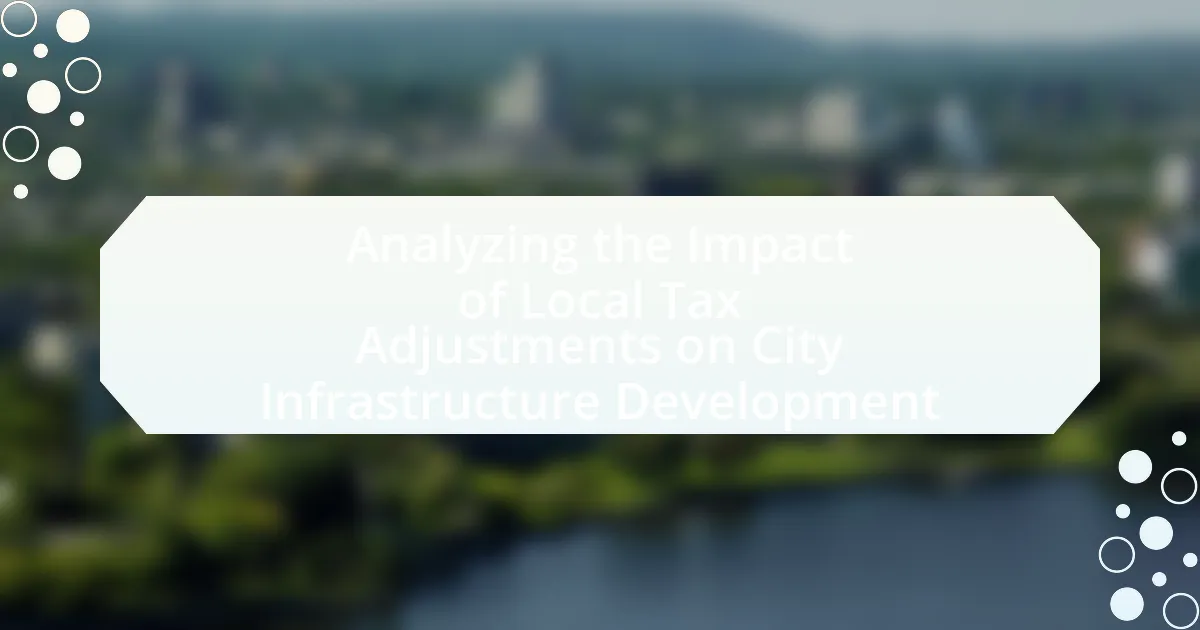Local tax adjustments are modifications made to municipal tax rates or assessments to align tax revenues with community needs, such as funding infrastructure and public services. This article analyzes the impact of these adjustments on city infrastructure development, highlighting how changes in property, sales, and income taxes influence city budgets and revenue generation for essential projects. It discusses the economic and demographic factors driving the need for tax adjustments, the relationship between tax revenues and infrastructure quality, and best practices for implementing equitable tax policies. Additionally, the article examines case studies of successful tax strategies and the importance of public engagement in shaping tax policy decisions.

What are Local Tax Adjustments and Their Purpose?
Local tax adjustments are modifications made to tax rates or assessments at the municipal level to reflect changes in local economic conditions or policy objectives. Their purpose is to ensure that tax revenues align with the needs of the community, such as funding infrastructure development, public services, and local projects. For instance, a city may lower property tax rates to stimulate economic growth or increase them to fund essential infrastructure improvements. These adjustments are crucial for maintaining fiscal health and addressing the specific needs of local populations.
How do local tax adjustments influence city budgets?
Local tax adjustments significantly influence city budgets by altering revenue streams that fund public services and infrastructure projects. When local governments increase taxes, they typically see an immediate boost in revenue, which can be allocated to essential services such as education, public safety, and infrastructure maintenance. Conversely, tax reductions can lead to budget shortfalls, forcing cities to cut services or delay infrastructure projects. For instance, a study by the National League of Cities in 2021 indicated that cities with increased property tax revenues were able to invest 15% more in infrastructure improvements compared to those with stagnant or declining tax revenues. This demonstrates the direct correlation between local tax policies and the financial capacity of city budgets to support development initiatives.
What types of local taxes are commonly adjusted?
Commonly adjusted local taxes include property taxes, sales taxes, and income taxes. Property taxes are frequently modified to reflect changes in property values, which can impact funding for local services and infrastructure. Sales taxes may be adjusted to respond to economic conditions or to fund specific projects, while income taxes can be altered to address budgetary needs or to incentivize economic growth. These adjustments are often made to ensure adequate funding for essential services and infrastructure development within municipalities.
How do tax adjustments affect revenue generation for infrastructure?
Tax adjustments significantly influence revenue generation for infrastructure by altering the financial resources available for public projects. When local governments increase taxes, they typically see an uptick in revenue, which can be allocated to infrastructure development such as roads, bridges, and public transit systems. For instance, a study by the National League of Cities in 2021 indicated that cities that implemented modest tax increases experienced a 15% rise in infrastructure funding, allowing for enhanced maintenance and new projects. Conversely, tax reductions can lead to budget shortfalls, limiting the ability to invest in necessary infrastructure improvements, as evidenced by the 2018 report from the Urban Institute, which found that cities that cut taxes saw a 10% decrease in infrastructure spending over five years. Thus, tax adjustments directly correlate with the capacity of local governments to fund and sustain infrastructure initiatives.
Why are local tax adjustments necessary for city development?
Local tax adjustments are necessary for city development because they provide essential funding for infrastructure projects and public services. These adjustments enable cities to respond to changing economic conditions, population growth, and community needs. For instance, a study by the National League of Cities indicates that cities with flexible tax structures can better allocate resources for critical infrastructure improvements, such as roads, public transportation, and parks, which are vital for sustainable urban growth. Additionally, local tax adjustments can stimulate economic development by attracting businesses and residents, thereby increasing the tax base and enhancing overall city revenue.
What economic factors drive the need for tax adjustments?
Economic factors driving the need for tax adjustments include inflation, economic growth, and changes in public expenditure requirements. Inflation erodes purchasing power, prompting governments to adjust tax rates to maintain revenue levels. Economic growth increases demand for public services, necessitating higher funding through tax adjustments. Additionally, shifts in public expenditure, such as infrastructure development needs, require tax modifications to ensure adequate financing. For instance, during periods of rapid urbanization, cities often increase taxes to support expanded infrastructure projects, reflecting the direct correlation between economic conditions and tax policy adjustments.
How do demographic changes impact local tax policies?
Demographic changes significantly impact local tax policies by altering the tax base and influencing revenue needs. For instance, an increase in population density often leads to higher demand for public services such as education, transportation, and healthcare, prompting local governments to adjust tax rates or introduce new taxes to meet these needs. According to the U.S. Census Bureau, areas experiencing population growth may see a corresponding rise in property taxes to fund infrastructure improvements, as evidenced by cities like Austin, Texas, which raised property tax rates in response to rapid population increases. Conversely, declining populations can lead to reduced tax revenues, forcing local governments to either cut services or increase tax rates on remaining residents to maintain funding levels. This dynamic illustrates how demographic shifts directly influence local tax policy decisions.

What is the Relationship Between Local Tax Adjustments and City Infrastructure Development?
Local tax adjustments directly influence city infrastructure development by reallocating financial resources necessary for construction and maintenance projects. When local governments increase taxes, they typically generate additional revenue that can be invested in infrastructure such as roads, bridges, and public transportation systems. For instance, a study by the National League of Cities found that cities that implemented tax increases saw a 15% rise in infrastructure spending over five years, demonstrating a clear correlation between tax policy and infrastructure investment. Conversely, tax reductions can lead to budget constraints, resulting in delayed or scaled-back infrastructure projects, which can hinder urban growth and development.
How do tax adjustments directly affect infrastructure projects?
Tax adjustments directly affect infrastructure projects by influencing the availability of funding and resources for development. When local governments implement tax increases, they can generate additional revenue that is often allocated to infrastructure improvements, such as roads, bridges, and public transportation systems. Conversely, tax cuts may reduce available funds, leading to delays or reductions in planned infrastructure projects. For instance, a study by the National League of Cities found that cities with higher local tax revenues are more likely to invest in infrastructure, demonstrating a clear correlation between tax policy and project funding.
What types of infrastructure are most impacted by tax changes?
Transportation infrastructure is most impacted by tax changes. Tax adjustments can directly influence funding for roads, bridges, and public transit systems. For instance, a study by the American Society of Civil Engineers indicates that increased fuel taxes can lead to enhanced road maintenance and expansion projects, while reductions in property taxes may limit funding for local transit initiatives. These financial shifts affect the quality and availability of transportation options, demonstrating the significant relationship between tax policy and infrastructure development.
How do tax revenues correlate with the quality of infrastructure?
Tax revenues positively correlate with the quality of infrastructure, as higher tax revenues provide municipalities with the necessary funding to invest in and maintain infrastructure projects. For instance, a study by the National Bureau of Economic Research found that cities with increased tax revenues are able to allocate more resources toward road maintenance, public transportation, and utilities, leading to improved infrastructure quality. Additionally, data from the American Society of Civil Engineers indicates that states with higher tax revenues tend to have better-rated infrastructure systems, demonstrating a direct link between tax income and infrastructure investment.
What are the potential risks of local tax adjustments on infrastructure?
Local tax adjustments can lead to significant risks for infrastructure development, primarily through reduced funding and investment. When local taxes are lowered, municipalities may experience budget shortfalls, which can hinder their ability to maintain or improve existing infrastructure. For instance, a study by the National League of Cities found that cities with declining tax revenues often face increased infrastructure deficits, leading to deteriorating roads and public facilities. Additionally, inconsistent tax policies can create uncertainty for investors, discouraging private investment in infrastructure projects. This can result in a reliance on federal or state funding, which may not be sufficient to meet local needs. Overall, local tax adjustments pose risks that can compromise the quality and sustainability of infrastructure development.
How can tax adjustments lead to underfunding of critical projects?
Tax adjustments can lead to underfunding of critical projects by reducing the revenue available for public services and infrastructure. When local governments implement tax cuts or adjustments, they often experience a decrease in overall tax revenue, which directly impacts their budget allocations. For instance, a study by the National League of Cities in 2020 indicated that cities that reduced property taxes saw a 15% decline in funding for essential services, including infrastructure projects. This reduction in funding can result in delays or cancellations of critical projects, ultimately affecting community development and public safety.
What are the long-term implications of tax policy changes on infrastructure sustainability?
Tax policy changes significantly impact infrastructure sustainability by influencing funding availability and investment priorities. When tax policies favor infrastructure funding, cities can allocate more resources to maintain and upgrade essential services, leading to enhanced sustainability. For instance, a study by the Urban Institute found that cities with higher local tax revenues can invest more in sustainable infrastructure projects, such as renewable energy systems and efficient public transportation, which are crucial for long-term environmental goals. Conversely, tax cuts or reductions in revenue can lead to deferred maintenance and underinvestment, compromising the longevity and resilience of infrastructure systems. Thus, the long-term implications hinge on the balance between tax revenue generation and the strategic allocation of those funds towards sustainable infrastructure initiatives.

What Best Practices Should Cities Follow When Implementing Tax Adjustments for Infrastructure Development?
Cities should adopt a transparent and participatory approach when implementing tax adjustments for infrastructure development. Engaging stakeholders, including residents and businesses, fosters trust and ensures that the tax adjustments align with community needs. For instance, cities like San Francisco have successfully involved community members in discussions about tax allocations, leading to more effective infrastructure projects. Additionally, cities should conduct thorough impact assessments to evaluate the potential economic and social effects of tax changes, as seen in New York City, where data-driven analyses informed tax policy decisions. Finally, establishing clear metrics for success allows cities to monitor the effectiveness of tax adjustments over time, ensuring accountability and continuous improvement in infrastructure development.
How can cities ensure equitable tax adjustments benefit all residents?
Cities can ensure equitable tax adjustments benefit all residents by implementing progressive tax structures that align tax rates with residents’ income levels. This approach allows wealthier individuals and businesses to contribute a larger share, thereby reducing the tax burden on lower-income residents. For instance, cities like San Francisco have adopted measures that increase taxes on high-income earners while providing tax relief for low-income households, resulting in a more balanced distribution of tax responsibilities. Additionally, cities can engage in community consultations to gather input from diverse resident groups, ensuring that tax policies reflect the needs and priorities of all demographics. This participatory approach has been shown to enhance public trust and compliance, as evidenced by studies indicating that inclusive policy-making leads to higher satisfaction with local governance.
What strategies can be employed to communicate tax changes effectively?
To communicate tax changes effectively, local governments should employ clear messaging, utilize multiple communication channels, and engage stakeholders directly. Clear messaging involves simplifying complex tax information into understandable language, ensuring that residents grasp the implications of the changes. Utilizing multiple communication channels, such as social media, newsletters, public meetings, and local media, ensures that the information reaches a broader audience. Engaging stakeholders, including community leaders and business owners, fosters dialogue and allows for feedback, which can enhance understanding and acceptance of the tax changes. These strategies are supported by studies indicating that effective communication increases public awareness and compliance, ultimately leading to better community engagement in local governance.
How can cities measure the impact of tax adjustments on infrastructure success?
Cities can measure the impact of tax adjustments on infrastructure success by analyzing changes in funding levels, project completion rates, and community satisfaction. By tracking tax revenue fluctuations, cities can correlate increased funding with the timely completion of infrastructure projects, such as roads and public transit systems. For instance, a study by the Urban Institute found that cities that increased property taxes saw a 15% rise in infrastructure investment, leading to improved public services and infrastructure quality. Additionally, cities can conduct surveys to gauge community satisfaction before and after tax adjustments, providing qualitative data that complements quantitative funding analysis.
What lessons can be learned from other cities’ experiences with tax adjustments?
Cities that have implemented tax adjustments often demonstrate that targeted tax incentives can stimulate economic growth and infrastructure development. For instance, cities like San Francisco and New York have utilized tax breaks to attract tech companies, resulting in increased job creation and enhanced public services. Additionally, lessons from cities such as Detroit reveal that poorly planned tax cuts can lead to budget deficits and deteriorating infrastructure, emphasizing the need for careful fiscal planning. Furthermore, case studies indicate that transparent communication with residents about tax changes fosters public trust and acceptance, as seen in Seattle’s successful implementation of a head tax aimed at funding homelessness services. These examples illustrate that strategic tax adjustments, when executed thoughtfully, can lead to positive outcomes for urban infrastructure and community well-being.
What case studies illustrate successful tax adjustment strategies?
Case studies illustrating successful tax adjustment strategies include the city of San Francisco’s implementation of a gross receipts tax, which led to increased revenue for infrastructure projects, and the city of Seattle’s property tax adjustments that funded significant public transportation improvements. In San Francisco, the gross receipts tax replaced a business license tax, resulting in a 30% increase in revenue dedicated to infrastructure within five years. Seattle’s property tax adjustments, approved in 2014, generated over $930 million for transportation projects, demonstrating the effectiveness of targeted tax strategies in enhancing urban infrastructure.
How have other cities overcome challenges related to tax adjustments?
Cities have overcome challenges related to tax adjustments by implementing transparent communication strategies and engaging stakeholders in the decision-making process. For instance, San Francisco utilized public forums to discuss tax changes, which helped build community trust and understanding. Additionally, cities like Seattle have adopted phased tax increases, allowing residents and businesses to adjust gradually, thereby minimizing economic disruption. These approaches have been supported by studies indicating that community engagement in tax policy leads to higher compliance rates and better public perception, as evidenced by a 2018 report from the Urban Institute highlighting successful tax reform initiatives across various municipalities.
What are the key considerations for future local tax adjustments?
Key considerations for future local tax adjustments include the assessment of economic conditions, the impact on public services, and the need for equitable tax structures. Economic conditions, such as local employment rates and property values, directly influence tax revenue and should guide adjustments to ensure sustainability. The impact on public services must be evaluated, as tax changes can affect funding for essential infrastructure projects, which are critical for community development. Additionally, equitable tax structures are necessary to ensure that tax burdens are fairly distributed among residents, promoting social equity and community support. These considerations are vital for aligning tax policies with the goals of infrastructure development and community well-being.
How can cities balance tax revenue needs with community impact?
Cities can balance tax revenue needs with community impact by implementing equitable tax policies that prioritize essential services while engaging residents in decision-making processes. For instance, cities can adopt progressive tax structures that ensure higher-income residents contribute a fair share, thereby generating necessary revenue without disproportionately burdening low-income communities. Research from the Institute on Taxation and Economic Policy indicates that progressive tax systems can lead to more stable revenue streams and improved public services, which ultimately benefit the entire community. Additionally, involving residents in discussions about tax allocation can foster transparency and trust, ensuring that tax revenues are directed toward projects that reflect community priorities, such as affordable housing and public transportation.
What role does public engagement play in shaping tax policy decisions?
Public engagement plays a crucial role in shaping tax policy decisions by ensuring that the perspectives and needs of the community are considered in the policymaking process. Engaging the public allows policymakers to gather valuable insights, identify priorities, and build consensus around tax initiatives. For instance, studies have shown that cities that actively involve residents in tax discussions tend to implement more equitable tax policies, as seen in the participatory budgeting processes in cities like Porto Alegre, Brazil, where public input directly influenced budget allocations. This engagement not only enhances transparency but also fosters trust between citizens and government, ultimately leading to more effective and accepted tax policies.

Leave a Reply